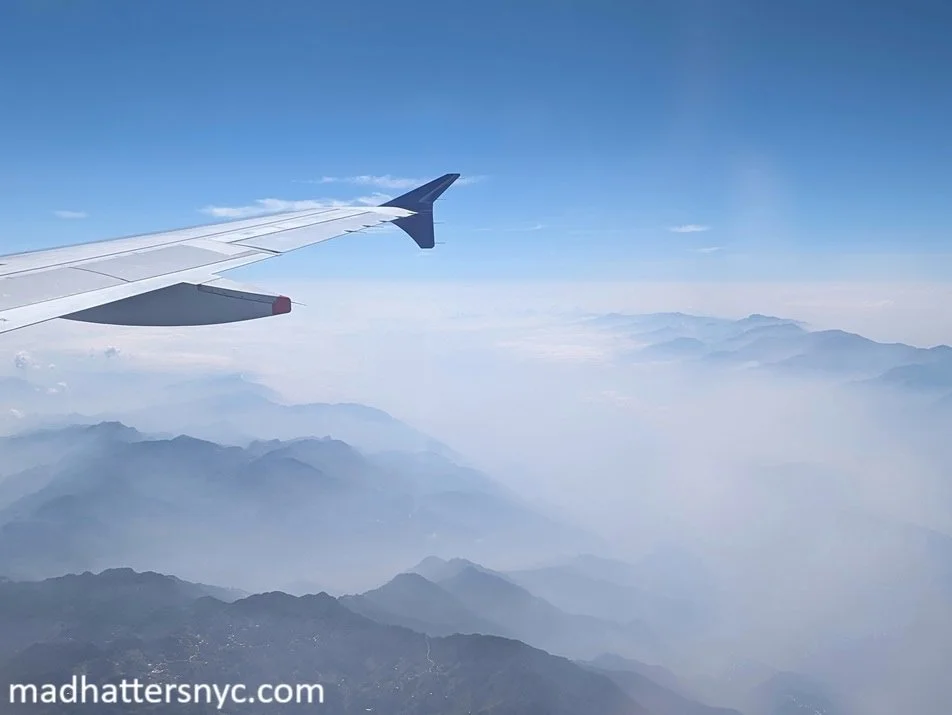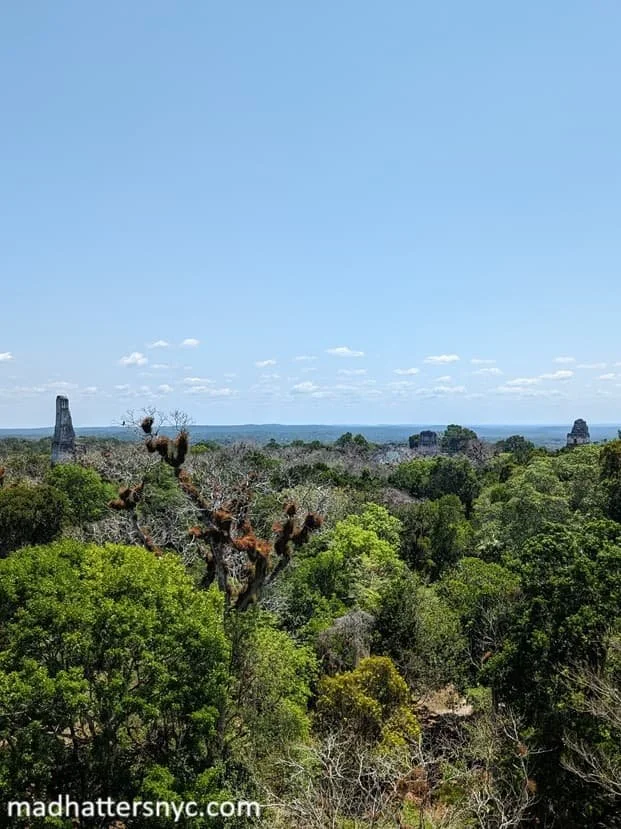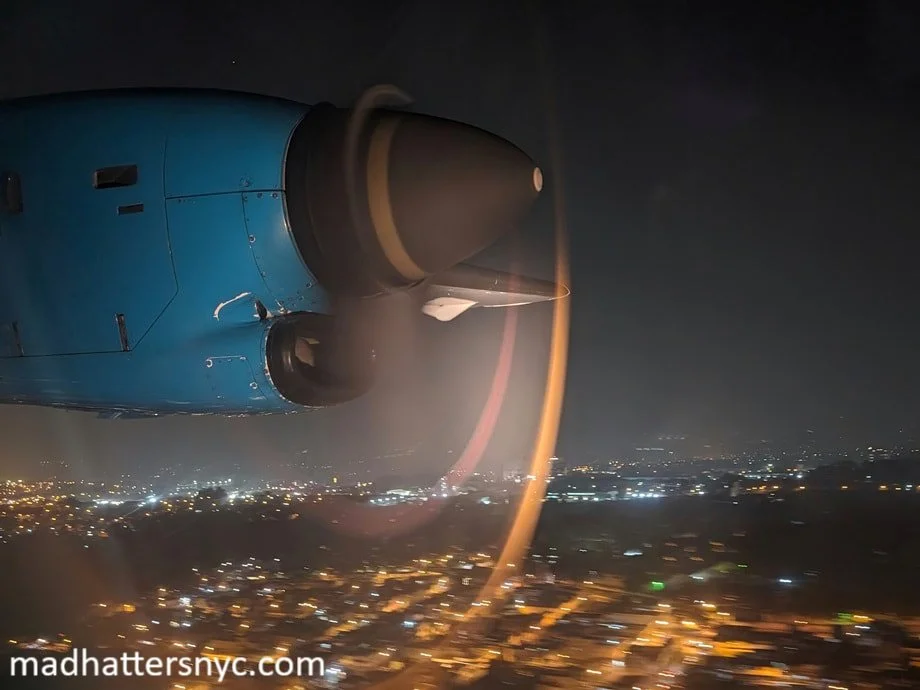48 Hours in the Maya World: Exploring Topoxte, Yaxha, and Tikal
When we planned our Guatemala trip, we weren’t sure if we should push ourselves to fit Tikal and its surroundings in. Located on the other side of the country, the Petén region holds countless treasures, but many choose to leave it off unless they are traveling across Guatemala. Embarking on a 48-hour journey through the ancient Maya cities of Topoxte, Yaxha, and Tikal is undeniably ambitious, but entirely possible. If you’re unsure how to do it, we’re going to dive into our whirlwind itinerary, packed with stunning landscapes and awe-inspiring archaeological sites.
Our 2-Day Itinerary for Topoxte, Yaxha, and Tikal
Day 1
Morning: Arrival in Flores
The amazing view on the GUA-FRS flight
6:00 am Scheduled flight time from Guatemala City to Flores. We received notice the night before from Avianca that our flight had been delayed to 9:00 am.
7:00 am We arrived at Guatemala City airport for our flight. It is generally recommended that you arrive 2 hours in advance, even for domestic flights.
9:30 am Our flight departed for Flores.
10:10 am We arrived in Flores. Flores is a small local airport, so disembarking and exiting is fairly hassle-free, with no additional checks at the airport upon arrival. We arranged an airport pickup through our travel agent, but Flores Island is only 10 minutes away from the airport and taxis are available.
Casa Ramona’s cheerful exterior
10:30 am Our travel agent met us at our hotel to collect payment for our arranged tours and provide additional details, like the meeting point for the group tour. Our hotel, Casa Ramona, didn’t allow early check-in, but allowed us to leave our luggage in the office. Casa Ramona also has an onsite restaurant and a common area, so we knew if we arrived early we would have a place to pass the time.
11:00 am We stopped for lunch at Restaurante Tipico Imperio, which was across the street from our hotel. The restaurant has a relaxed atmosphere and a great view of the water. We even spotted a heron as we waited for our meal to arrive!
Afternoon: Topoxte and Yaxha Tour
Stunning street art can be seen on the way in and out of Flores
12:00 pm We arrived at the meeting point for our shared tour. The van seated approximately 20 people, and we waited 15-20 minutes for additional participants to arrive. It was almost full when we left.
The drive to Yaxha takes 2 hours from Flores. There was some air conditioning in the van, though it struggled to keep up in extreme heat. We stopped in El Remate to pick up 4 additional tour participants, which put the van at capacity. As we got closer to Yaxha, we found ourselves on some winding dirt roads, but the drivers were clearly very familiar with them.
1:45 pm The tour operators advised us that there are no stores in Yaxha, so they would be stopping at a local shop just 10 minutes away to allow us to purchase snacks and drinks. Everyone exited to procure refreshments and stretch their legs. After a short 15-minute break, we were back on our way.
On our boat ride to Topoxte
2:10 pm We arrived at the parking area of Yaxha-Nakum-Naranjo National Park. Shared tour prices do not include the cost of admission, which is 80Q for foreigners. (Please note that admission is free for Guatemalan nationals on Sundays, so it may be busier than usual.)
Once we paid our entrance fees, the tour group split. Those of us heading to Topoxte hopped on a small motorized boat, while those only visiting Yaxha continued on in the van. When we entered the boat, we were warned to keep arms and feet within the confines of the boat, since there are crocodiles in the lake (!). The boat ride took approximately 20 minutes.
The unique green tint to Lake Yaxha’s water
The name Yaxha derives from the Mayan yaxa', which directly translates to "blue-green water". It is only when traveling on Lake Yaxha to Topoxte that you get a close-up view of the unique green color of the lake’s water.
Pro Tip: Tours to Topoxte are usually conducted separately, but for a few months in the year, when the sun sets after 6:00 pm during the dry season, there is enough time to combine the tours. This period usually falls between mid-February and mid-May. Since we visited in early May, we were able to take advantage of this opportunity. Adding Topoxte to the Yaxha tour only cost an additional $10.
2:55 pm Arrived at Topoxte.
Topoxte (pronounced Toh-pohk-shtay) is situated on a group of small islands in Lake Yaxha. This unique setting distinguishes Topoxte from other Maya sites. Topoxte has an early settlement history dating back to the Middle Pre-Classic Era, and also survived as a viable settlement until 1450 BCE, revealing an occupational history of over 2,000 years, extending far beyond Yaxha’s.
Our guide, Nelson, showed us the local flora and fauna, and led us to the main ceremonial structure, which is dedicated to the God of Maize.
4:00 pm We left Topoxte for Yaxha.
4:20 pm We docked at Yaxha, and proceeded on our long climb to the central Plaza.
Yaxha (pronounced Yahk-sha) is located over a hill surrounded by the Sacnab and Yaxha lagoons, and more than 1700 structures have been identified there. Yaxha appears to have been an important city within the region during its peak, becoming a religious center and controlling the aquatic routes of the Yaxha lagoon.
-
Throughout their histories, Yaxha and Tikal likely experienced fluctuating relationships, ranging from trade partnerships to political alliances and possible conflicts. According to the National Park’s website, although Yaxha is believed to have been within Tikal’s sphere of influence, it was repeatedly conquered by Naranjo, a vassal of Calakmul in Mexico, and had only brief periods of independence.
Juego de Pelota, where the Mayan ball game was played
At Yaxha’s South Acropolis, a point of interest was the Juego de Pelota, or ball court. The ball game was prevalent in Maya society, with lots of spectators gathering on the high platforms on either side of the court. Surprisingly, the ball game wasn’t played as entertainment, but to keep the gods happy. It is believed there was also an aspect of human sacrifice, with the losing captains or kings sacrificed to the gods.
We proceeded to the impressive North Acropolis, which is home to three impressive pyramids. The North Acropolis was once the most important ritual center, making Yaxha the most developed site in the lake basin. The sun was beginning to recede into the horizon, which was an impressive sight with the pyramids in the foreground. But the main sunset show is yet to come!
The viewing platform on Temple 216 at Yaxha’s East Acropolis
Sunset view over Lake Yaxha from Temple 216
5:40 pm We ended our Yaxha visit at Temple 216 in the East Acropolis , the tallest temple in the ancient city. With spectacular views of the lake, it is the perfect vantage point from which to take in the stunning Guatemalan sunset.
After hiking up the wooden stairs and arriving at the viewing platform, visitors are encouraged to enjoy the view in silence, so as to take in both the sights and sounds of the jungle. After a long day on the go, sitting quietly while we enjoyed the sunset felt like a meditative experience.
The Yaxha-Nakum-Naranjo National Park closes after sunset, so we made our way back to the parking lot and hopped on the shuttle back to Flores.
Night: Arrival back in Flores and Dinner
8:30 pm We arrived back in Flores.
9:00 pm We had intended to dine at Maracuya, a cute eatery with an eclectic menu. Whether you’re craving a traditional Guatemalan dish or pasta, a burger or a colorful vegan bowl, the menu seemed able to accommodate. However, we arrived without a reservation at 9:00 pm, and faced a 45-minute wait. Seeing as the restaurant closed at 10:00 pm and we had an early morning, we pivoted. We headed to La Danta, situated right next to our hotel, and enjoyed a simple meal from there instead.
Day 2
Morning: Hotel Check-out and Tikal
Early morning view of Calle de Septiembre as we left
7:00 am We had arranged a private tour in advance through a local travel agency. Our private tour of Tikal included round-trip transportation to and from the park, so our guide and his driver picked us up from the hotel. Since we were in a private vehicle and he offered to take us directly to the airport from Tikal, we checked out and placed our bags in the car.
-
We initially considered a sunrise tour of Tikal which would require a 3:30 am departure from Flores, but after conducting some research and discussing it with our tour guide, we learned sunrises are rarely visible from Tikal due to fog. He confirmed there is better success with sunsets, but, if you only have one sunset opportunity, the view from Yaxha overlooking the lake is much more impressive. Also note there is an additional park fee if you want to arrive in Tikal for sunrise before the park officially opens. After weighing the effort vs. the reward, we decided we would forego the sunrise tour in favor of a couple more hours of sleep.
8:00 am We arrived in Tikal and dropped by the Visitor Center, where a miniature model of the park really puts its scale into perspective. Tikal National Park encompasses over 222 square miles (575 square kilometers) of protected rainforest, offering visitors a unique opportunity to experience both the natural and historical wonders of the region.
Pro Tip: Unlike Yaxha, you can purchase your tickets for Tikal online. Remember to purchase the tickets for foreigners, which are 150Q per person. You should receive PDF tickets in your email, but a screenshot with the confirmation number is sufficient.
The soaring pyramid of Temple V
9:00 am Though most visitors overlook it, we started our tour of Tikal at Temple VI. The modest temple is also called the Temple of Inscriptions because of the hieroglyphic text adorning its sides and back. The inscriptions go back to 1143 BCE, predating the site itself, suggesting it captures the origins of Tikal.
Then we headed to Temple V, the second tallest building at TIkal and the most massive structure at any Maya site. Built by the 22nd ruler of Tikal in 600 CE, the 170-foot pyramid was a burial site where obsidian and ceramic offerings were found.
The coati, a member of the raccoon family
At the Plaza of the Seven Temples, we found residential and administrative-style structures, as well as 3 ball courts. Here, we also encountered our first coati! The park's wildlife, which includes howler monkeys, toucans, and jaguars (don’t worry, they’re nocturnal!), adds to the magical atmosphere of exploring an ancient city reclaimed by nature. All throughout our visit, our guide, Sergio, pointed out native plants like the Ramon tree, and identified native wildlife, like the noisy brown jay.
The tops of the pyramids peeking through the trees
Mundo Perdido, or the Lost World Complex, was one of our Tikal highlights, as it includes an ancient astronomical observatory that underscores the Maya's advanced understanding of astronomy. The buildings were used to plot the sunrise on the equinoxes and the solstices. The platform here provides one of the best views of Tikal. Once you climb to the top, you can see the pinnacles of the towering temples peeking through the lush tree lines, and you can truly appreciate the site’s full landscape.
The Talud-Tablero Temple
To the west, the Talud-Tablero Temple is also worth noting, as it is evidence of Teotihuacan’s far-reaching influence. Named for its architectural style, Talud-Tablero consists of alternating layers of horizontal steps and angled vertical walls and was prominent in the ancient city.
-
Tikal is considered the heart of ancient Mayan civilization in Guatemala. Though Teotihuacan in Mexico is regarded as the first true Mesoamerican metropolis dating back to 300 BCE, Tikal is one of the largest and most significant Mayan cities. Flourishing between 200 and 850 CE, Tikal was a dominant political, economic, and military center, playing a crucial role during the Late Classic Era. There is evidence that around 378 CE Teotihuacan invaded Tikal, alluding to an established power challenging the rise of a newer one.
Since the climb up Temple 216 at Yaxha the night before pushed the limits of Lynn’s fear of heights, we declined to climb Temple IV. It is the tallest structure in Tikal standing at 230 feet (70 meters) and provides breathtaking views of the jungle canopy.
Pro Tip: If you skipped climbing up the platform at Mundo Perdido and you’re not up to climbing Temple IV, you can still get a glimpse of Temple IV’s peak from the Windows Palace.
We made a short stop at Temple III, or the Temple of the Jaguar Priest, which is significant because it is the last temple built in Tikal in 810 CE. And then, we were on our way to the Great Plaza.
Afternoon: Tikal’s Great Plaza and flight back to Guatemala City
The impressive Temple I in Tikal’s Great Plaza
The Great Plaza is Tikal’s crown jewel, where you’ll find Temple I, Temple II, the North Acropolis and the Central Acropolis. Temple I is also known as the Temple of the Great Jaguar, the tomb of the ruler Jasaw Chan K'awiil I. Jasaw Chan K'awiil I’s reign is remembered as a golden age for Tikal. One of his most celebrated achievements was his victory over Calakmul, Tikal's long-standing rival, in 695 CE. Temple I served as his funerary monument and symbolizes the architectural and artistic achievements of his reign. At an impressive 154 feet (47 meters), Temple I remains one of the most photographed and visited structures at Tikal.
Temple II, also known as the Temple of the Masks, is a pyramid that was built by Jasaw Chan K'awiil I in honor of his wife. It faces Temple I across the Great Plaza, creating a harmonious architectural ensemble that showcases the grandeur of Tikal.
Well-preserved stone sculptures at the North Acropolis
The North Acropolis is one of the most significant and ancient architectural complexes at Tikal, serving as a central hub for religious, ceremonial, and political activities over many centuries. This acropolis is crucial for understanding the evolution of Tikal's dynastic history and architectural development. The acropolis is adorned with numerous stelae and altars, many of which are intricately carved with hieroglyphs and images depicting Tikal’s rulers and their achievements.
After we spent some time at the Great Plaza, our guide asked us if we wanted to visit the Twin Pyramids Complex, but we knew we had to be at the airport by 3:30 pm, so we decided to leave some time to grab lunch before our flight. Even though Flores is a small, regional airport, you are still required to arrive 2 hours prior to your flight departure time.
1:30 pm We left Tikal for the airport.
2:30 pm Sergio dropped us off at the Flores airport, which has a small cafe next door. There is also an overhead bridge to cross the highway, where a number of fast food restaurants like Pizza Hut and McDonald’s are located.
3:30 pm We were advised our flight had been delayed. We headed through security to the departure lounge, which was pleasantly air conditioned and had a little coffee shop offering refreshments and light bites.
A beautiful view approaching Guatemala City at night
7:00 pm We boarded our Tag Airlines flight, which departed 1.5 hours later than scheduled. The twin turboprop plane might be unnerving for some. However, we found it comfortable and felt perfectly safe.
8:15 pm We arrived back in Guatemala City.
Important Planning Tips
When we were planning this ambitious portion of our Guatemala trip, we knew we would have to prepare for plans to go awry and formulate contingencies. To do this, prioritizing is key. We knew Tikal was the most important site and the only one we didn’t want to miss.
Getting from Guatemala City to Flores
Tag Airlines twin turboprop plane
Guatemala City’s La Aurora Airport (GUA) is the country’s main international airport. Tikal is located in northeast Guatemala, on the other side of the country. To get to Tikal by air, one would need to fly into Flores Airport (FRS), the gateway to the Maya Biosphere Reserve.
The domestic flight between Guatemala City and Flores is only 50 minutes long, and the route is served by two airlines: Avianca and Tag Airlines. Avianca is the largest airline in Colombia and a member of the Star Alliance, while Tag Airlines is a private Guatemalan carrier. When researching, we discovered neither one was particularly timely, but Tag Airlines had a significantly poorer record of customer resolution if flights were canceled. Schedules can be fickle, both Avianca and Tag Airlines had early morning flights to Flores leaving at about 6:00 am, however, on our return dates Avianca only offered a morning flight and we knew we needed enough time to explore Tikal. We booked our outgoing flight with Avianca and our return flight with Tag Airlines.
Here’s where the contingencies come in. We knew that if our Avianca flight was canceled or delayed, we may not be able to visit Yaxha and Topoxte, but we would still be able to take an overnight bus and arrive in time to see Tikal. Similarly, we knew that if our Tag Airlines flight was canceled, we could still make it back to Guatemala City on the overnight bus and continue with our Guatemala travel plans. There are several bus companies with daily service between Guatemala and Flores (the destination is called Santa Elena) as well as directly to Tikal, like Cristobal Colon and Fuente del Norte, and you can buy tickets in person right until departure.
Booking Tours in Advance
If you search for Tikal tours online, you’ll find the usual slate of offerings: a mix of private tours and shared tours. If your schedule is somewhat in flux, then it might make sense to hold off on booking tours in advance. Since we were prioritizing Tikal, we decided to splurge on a private tour. (We decided to take a private tour to Pacaya Volcano from Antigua for similar reasons.)
Shared tours are more flexible and can accept participants up until the day of. We advised our travel agent that we were interested in a shared tour of Yaxha, so he notified us what time the group tour would leave, and continued to check in on the status of our flight to ensure we would make it. We arrived with just enough time to drop our bags off, have lunch, and join the tour.
What We Would Have Done Differently
One of the many colorful exteriors on Flores Island
We’re extremely happy we decided to push ourselves to do Tikal, and in the end, even despite some delays, everything worked out. But if we were to do it over again, we probably would have added another day just to allow ourselves a little more freedom.
Also, we were unexpectedly charmed by Flores! Our initial read of the place was that it could have more of a party atmosphere, but that was not our experience at all. Flores has a chill island vibe, and everyone we came across was welcoming and kind. Flores is built on the ruins of the ancient Maya city of Tayasal, which was one of the last Maya strongholds to resist Spanish conquest until 1697. Tayasal was the capital of the Itza Maya. Named after Cirilo Flores, a prominent figure in Guatemalan history, the town became a colonial administrative center. We would’ve loved more time to explore it.
So, if you can afford an additional day to pad your visit to the area, we highly recommend it.
Conclusion
Embarking on a 48-hour adventure through the ancient Maya sites of Topoxte, Yaxha, and Tikal is undeniably ambitious, yet entirely achievable. While the itinerary is tight, the effort is richly rewarded. So, gear up for an unforgettable 2 days in the Petén region! This adventure promises not only a glimpse into the ancient past but also an enduring appreciation for the ingenuity and resilience of the Maya civilization. Prepare to be amazed and inspired.





















